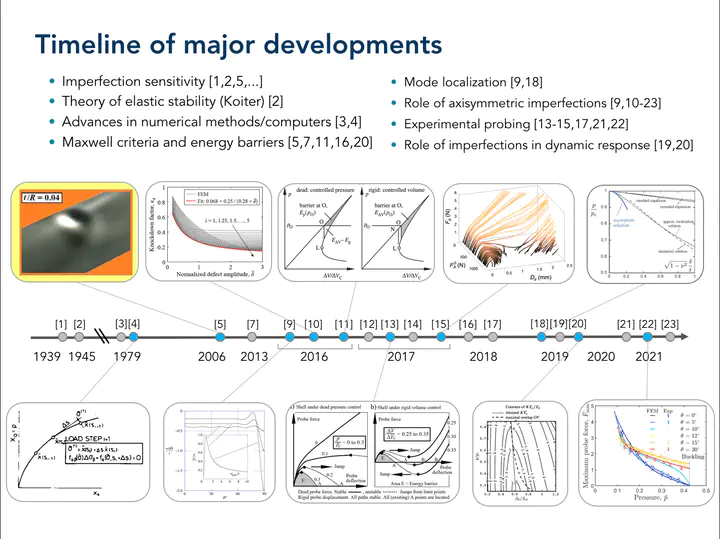Stability of Thin Shells

Overview
Recent advances in the understanding of stability in thin shells have been made by focusing on the localized nature of their post-bifurcation behavior, as opposed to historical efforts [W1] to rationalize the post-bifurcation response in terms of the classical global mode of Zoelly [W2]. In 2016, John Hutchinson elucidated how the classical global post-bifurcation mode of a spherical shell under uniform external pressure rapidly evolves into a stable, highly localized mode after bifurcation [W3]. He demonstrated that for realistically sized localized dimple-like imperfections
Question
Can we predict the knockdown factor
- [W1] Warner Koiter. “The nonlinear buckling behavior of a complete spherical shell under uniform external pressure, Parts I, II, III & IV”. Proc. Kon. Ned. Ak. Wet, 1969.
- [W2] Robert Zoelly. “Ueber ein Knickungsproblem an der Kugelschale”. PhD Thesis. 1915.
- [W3] John Hutchinson. “Buckling of spherical shells revisited”. In: Proceedings of the Royal Society A: Mathematical, Physical and Engineering Science, Nov 2016.
- [W4] Anna Lee et al. “The Geometric Role of Precisely Engineered Imperfections on the Critical Buckling Load of Spherical Elastic Shells”. In: Journal of Applied Mechanics, Aug. 2016.
- [W5] J. M. T. Thompson and G. H. M. van der Heijden. “Quantified ’shock sensitivity’ above the Maxwell load”. In: Int. J. Bifurcation & Chaos, 2013.
- [W6] Jiri Horak, Gabriel J. Lord, and Mark A. Peletier. “Cylinder Buckling: The Mountain Pass as an Organizing Center”, 2006.
- [W7] John Hutchinson and John Thompson. “Nonlinear Buckling Interaction for Spherical Shells Subject to Pressure and Probing Forces”. In: Journal of Applied Mechanics, June 2017.
- [W8] Joel Marthelot et al. “Buckling of a Pressurized Hemispherical Shell Subjected to a Probing Force”. In: Journal of Applied Mechanics, Sept. 2017.
- [W9] Emmanuel Virot et al. “Stability Landscape of Shell Buckling”. In: Physical Review Letters, Nov. 2017.
- [W10] John Hutchinson and John Thompson. “Imperfections and Energy Barriers in Shell Buckling”. In: IJSS, Jan. 2018.
- [W11] Simos Gerasimidis et al. “On Establishing Buckling Knockdowns for Imperfection-Sensitive Shell Structures”. In: Journal of Applied Mechanics, June 2018.
- [W12] Kshitij Yadav et al. “A Nondestructive Technique for the Evaluation of Thin Cylindrical Shells’ Axial Buckling Capacity”. In: Journal of Applied Mechanics, Jan. 2021.
- [W13] Arefeh Abbasi, Dong Yan, and Pedro Reis. “Probing the buckling of pressurized spherical shells”. In: Journal of the Mechanics and Physics of Solids, June 2021.
- [W14] Dong Yan et al. “Magneto-active elastic shells with tunable buckling strength”. In: Nature Communications, May 2021.
- [W15] Fabien Royer, John W. Hutchinson, and Sergio Pellegrino. “Probing the stability of thin- shell space structures under bending”. In: International Journal of Solids and Structures, 2022.